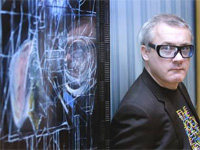 Julian Spalding: Damien Hirsts are the sub-prime of the art world
Julian Spalding: Damien Hirsts are the sub-prime of the art world
Some people argue that Damien Hirst is a great artist. Some say he is an execrable artist, and others put him somewhere more boring in between. They are all missing the point. Damien Hirst isn't an artist. His works may draw huge crowds when they go on show in a five-month-long blockbuster retrospective at Tate Modern next week. But they have no artistic content and are worthless as works of art. They are, therefore, worthless financially.
If you want a pickled shark in a tank, you don't have to pay the $12m Steve Cohen paid for the one selected by Hirst. You only pay that much for the artistic content that Hirst has added to it. If there isn't any, what are you buying? You could argue that you are buying an investment. But that depends on people in the future valuing the artistic content in your shark even more highly than you do. If they don't, what are you left with? A shark in a tank, which is what you bought.
I've coined the term Con Art, short for contemporary conceptual art and for art that cons people. Contemporary conceptual art? All art is a concept in the sense that it's the product of thought. But all art must also be a creation. You have to be able to see art; it can't just be a projected thought. That's how the emperor got dressed; his expensive robes were all in the minds of people around him, when in reality he had nothing on.
It's often been proposed, seriously, that Damien Hirst is a greater artist than Michelangelo because he had the idea for a shark in a tank whereas Michelangelo didn't have the idea for his David. What separates Michelangelo from Damien Hirst is that Michelangelo was an artist and Damien Hirst isn't. Michelangelo's extremely subtle, profoundly moving ideas were manifest in what he made; they weren't pretentious profanities tossed off the top of his head.
The trouble with found objects is that you can't tell just by looking at them what the person who put them in front of you is trying to tell you unless he or she has altered them in some meaningful way. Nor does the act of placing something in an art gallery, whether it's a stack of bricks, a bin bag or an unmade bed, automatically make it a work of art, any more than framing a canvas with paint on it automatically makes it a painting. Art can be made out of anything, as Picasso famously demonstrated when he put a bicycle saddle and handlebars together and made a bull's head, but art has to be made.
Where did this idea that anything could be a work of art come from? It's generally believed to have come from Marcel Duchamp. In 1917, a urinal was sent to an art exhibition in New York, supposedly by Duchamp. But recent research has shown that the urinal was actually submitted by Baroness Elsa von Freytag-Loringhoven. Her gesture was an early feminist attack on a male society. She didn't claim the urinal was a work of art. She was taking the piss.
Duchamp stole her idea much later when he began to promote himself as the founding father of modern art. The whole idea of the found object – the basis of conceptual art – was a con from the start. Why did the idea that anything could be art catch on? Con artists, cashing in on Duchamp's scam, chose a few found objects and sold them to gullible collectors as gilt-edged investments, with the help of a small coterie of dealers and museum curators who wanted to be at the forefront of art no matter what the public thought. The bubble that is Con Art blew up, like the sub-prime mortgage business, in the smoke-and-mirrors world of financial markets, where fortunes have been made on nothing.
The art education world, strapped for funds, has clung to the Con Art bandwagon, because thinking costs less than making. It doesn't involve learning craft skills in studios. Damien Hirst's ghastly reputation glows in the black hole at the heart of British culture.
Art is a collective reality. When we look at a Rembrandt, we all know we are looking at the same thing, responding to the same source of experience outside ourselves. We might respond slightly differently, according to our natures, but the heart of what Rembrandt has given us is something we know we can share. What art shows might be painful, even vicious, but the showing is beautiful because it is shared. That is the optimism in all art – it helps us to build our collective consciousness on which the future of civilisation depends.
Real art is always positive, for if it wasn't why would anyone make it or want it? Con art is negative: it gives us nothing. That's why you'd be well advised to sell your Hirsts, if you've been unfortunate enough to acquire any, before they become worthless. Because worthless they will be, when everyone realises that they've given nobody anything. Damien Hirst's "works" are only of value if they're works of art. They're not. That's the naked truth.
'Con Art – Why you ought to sell your Damien Hirsts while you can', by Julian Spalding, is published 1 April and available via Amazon Kindle
 Julian Spalding: Damien Hirsts are the sub-prime of the art world
Julian Spalding: Damien Hirsts are the sub-prime of the art world